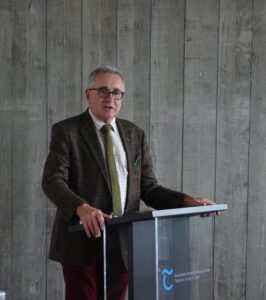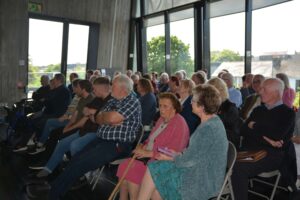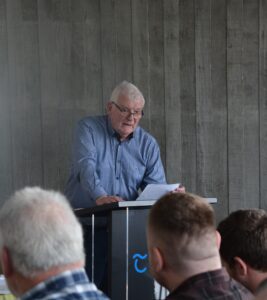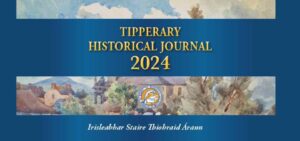Review of the Tipperary Historical Journal 2024
Launch of Tipperary Historical Journal 2024
W. Nolan
The well-known sculptor Jarlath Daly launched the 2024 issue of the annual Journal of the Tipperary Historical Society on Saturday 8 June in The Source Thurles. Jarlath is a native of Tipperary Town where his family had a bakery business. Indeed, Jarlath linked the art of making bread to his chosen career though he is now moulding bronze rather than kneading dough. He was a teacher at second-level for a number of years before taking the courageous step of committing himself full-time to sculpting. He told the audience that his inspiration for his creations is derived from history, sport and nature.
Jarlath had done his homework on the contents of the Journal for 2024, which incidentally is edited by Dr. Denis G.Marnane, another native of Tipperary Town. Describing the Journal as an eclectic mix of essays, which extended from the local level of the townland to embracing regions of the wider world to which Tipperary people had connections.He was pleased to find that the first essay brought him home to Tipperary Town. This was the study by Ross Drummond and Lydia Cagney of new archaeological evidence for the town in the medieval period. There followed a detailed account by German –based Kathleen Macqueen on Marlfield Distillery 1817-1857. This enterprise, Jarlath noted, linked the families of Jameson, Stein and Haig long synonymous with the whiskey industry in Britain and Ireland. Apart from the economic crisis consequent to the Great Famine, the temperance campaign led by the messianic figure of Fr. Mathew, a native of Thomastown, Co. Tipperary, inspired some three million people to take the pledge which didn’t help the prospects of the Marlfield Distillery.
Dr. Denis G.Marnane in the fourth essay turns to the lifestyle of the profligate John Meade, 1st earl of Clanwilliam. After his death on 19 October 1800, the vast Meade estate was so debt-ridden that a sale of the Tipperary portion was authorised for June 1805. The details on the twenty-two lots, mainly around Golden, auctioned indicate that the sale had a shaping influence on landownership in this region in the nineteenth century. Apart from selling land, a later option for landlords anxious to improve the future economics of their estates was to rationalise farm size by assisting selected tenants to emigrate to either America, Canada or Australia. In his essay John Keating, a native of Grange, Ardfinnan, examines the emigration scheme organised by Richard, 4th Earl of Donoughmore, from his estate at Knocklofty in 1853. Donoughmore assisted some 200 people to emigrate to North America a venture which Monsignor Michael Burke, the combative parish priest of Sts Peter and Pauls, Clonmel, was bitterly critical of.
Dr Maura Cronin, who has connections with the O’Hickey family of Carrickbeg, Carrick-on-Suir, has a very positive and beautifully written review article on William Nolan’s two-volume study of Young Ireland, The Rising at Farranrory, Ballingarry, and its aftermath. Daniel Grace of Nenagh, chairman of Tipperary Historical Society, follows with a fascinating insight into the trauma caused to an already traumatised population in Nenagh Poor Law Union by the cholera outbreak of 1849. One of the purposes of historical research is to allow us compare the comparative prosperity and compassionate social welfare arrangements of modern times with the horrors which the poorest in the population faced in the awful Famine years from 1845 to 1849 with which this essay is concerned. Miriam Lambe, who has Templederry connections, details the relationship of Angela Burdett Coutts, described as the richest heiress in Britain, to the Otway family, landlords of Templederry. Angela’s sister Sophia was married to Robert Otway Cave and it seems her family’s wealth may have helped to finance Cave’s elections as MP first for Leicester and secondly for Tipperary, which he represented in 1832 and from 1835 to 1844.On the death of her husband Sophia expended money on improvements at Templederry, but such work was halted when Tim Hanley, a wood ranger and caretaker of Castle Otway, was murdered in October 1847.
Liz Rushen, the distinguished Australian historian, has a fascinating essay on Tipperary town native Edmund Finn whose family emigrated from the town to Melbourne in March 1841. Rushen captures turbulent Tipperary in pre-Famine times and then chronicles Edmund Finn’s rise to prominence as a journalist, author and adviser to another distinguished Tipperary immigrant, John O’Shanassy, who was three times premier of Victoria between 1857 and 1863. Finn is best remembered today as the author of the two–volume The Chronicles of Early Melbourne, 1835- 1852which he published in 1888. Jim Coghlan of Melbourne writes about Edward (Ned) McGlinn, his great-great-grand uncle, who was one of the twenty-seven killed in the Battle at Eureka Stockade at Ballarat in 1854, one of the defining events in the shaping of modern Australia. McGlinn was the only Tipperary man among the eleven natives of Ireland killed, when they stood with their leader Peter Lalor under the flag of the Southern Cross to demand rights for miners. Danny Cusack, a native of Perth, but now resident in Co. Meath, concludes the trilogy of Australian essays with an insightful account of the life of Fr. John Fahey (1883-1959) who came from the townland of Glenlough in the parish of Rossmore. Educated at Mount Melleray and then at a seminary in Genoa, Italy, Fahey served as a curate in the rural hinterland of Perth, Australia, before joining the Australian Imperial Forces on the outbreak of World War One. He was one of the few chaplains to disembark at Gallipoli in Northern Turkey and witnessed at first hand the carnage of war. Fahey wrote riveting accounts of the awful slaughter there. The Rossmore man was not finished with war and in 1916 he was posted with his battalion to the killing fields of Pozieres and the Somme on the Western Front. Returning as a hero to Perth, Fr. Fahey had subsequently a more conventional priestly life.
Thurles-based Denis Kenny has an account of the life and career of Bansha-born Thomas P. Givens. From a strong-farmer background, this son of a Protestant father and Catholic mother also attended the Abbey School, Tipperary. Givens emigrated to Shanghai and ended his career there as the Head of the anti-Communist Bureau of the Shanghai Municipal Police. Kenny hints that the Bansha man was involved in some murky activities in that role, but he survived to return to Bansha as owner of Bansha Castle and a substantial farm. There is an interesting photograph of Givens in the company of Canon Hayes, founder of MuintirnaTíre, whose work on behalf of rural communities he supported. Seamus King, Lorrha–native and historian of the GAA, traces the process of building a new line of road between Ballinacor to Lorrhain the 1890s. It seems the logistics of road construction has little changed since then. The route had to be identified, the Grand Jury had to agree to finance it and the lands required had to be purchased. There was some opposition but the support of the Catholic clergy and the local landlord, Trench of Moatfield, Redwood, ensured its completion.
J.M. Tobin, Turtulla, Thurles, contributes an important essay on the development of education facilities for the poor boys of Thurles in the early nineteenth century. The early school was established by a small group of men who lived together as a kind of embryonic religious community. Gradually these men or monks became integrated into the Irish Christian Brothers, a religious order founded by Edmund Rice and given formal recognition in 1822.It was believed that the Christian Brothers School in Thurles dated from 1816 but Tobin has clearly shown that 1822 is the correct date. Donal J. Regan, Templemore, vice-chairperson of the Tipperary Historical Society, has a note of Fr. John Mackey (c. 1800- 1891) of Castleiney. It seems that Fr. Mackey had problems with alcohol and may have been silenced. Such priests were revered by their communities as having special powers and Fr. Mackey’s memory is commemorated in the Blessed Well at Ballinalassa, Castleiney, that he, according to tradition, miraculously created. Dr. Denis G. Marnane, citing a document in the archive of the Armitage landed family of Noan, Ballinure, recently acquired by Tipperary County Library, relating to the killing of an alleged spy, who was an employee of the Armitages, three days before the Truce on 8 July 1921. The document is a letter to his children from Frederick Armitage and is addressed from a hotel in Holyhead to where the Armitages had travelled to avoid further hostilities in Ballinure.
Annette Condon, Cahir, contributes an essay on her relative Marian Tobin nee Carew who married into the Tobin family of Tincurry House near Cahir. Through words and original photographs, for the first time published, she shows that the Tobins provided a safe house and training centre for the IRA at Tincurry. After the early death of her husband,Marian Tobin was a successful candidate in the County Council elections of 1920.Tincurry House was burned to the ground as a reprisal for the shooting of Inspector Potter of the RIC but was rebuilt in 1932. This essay traces the political evolution of the Tobins from Young Ireland to Land League to Sinn Féin but the author is careful to stress that members of the family also fought on the British side in both World War One and World War Two.In one of the more memorable essays in the collection, Bridie Garret Fennessyrecalls the time she spent working as a domestic servant in the Big Houses of Marlow (Pennefather) and Moyaliffe (Armstrong- Kemmis). Now a sprightly ninety years of age, she chronicles in great detail the last years of two landlord families long synonymous with their Tipperarys. It is a fascinating account as we are literally brought inside the Big Houses with Bridie as our incisive tour guide. These self-sufficient islands apart valiantly held on to a lifestyle marked by very British decorum and routine as it is revealed here from the horseradish to the mint sauce. But bereft of rental income and with no heirs willing to take them on their time was done.
John Phayer records the story of another woman of distinction, Mary Anne O’Brien (1860 – 1937), one of the founders of the Mercy Convent, Newport, Co. Tipperary. Mary Anne entered religious life after the premature death of her husband and her old family home became the centre of the new foundation. Richard Meehan, Clonmel, writes about Lilla Perry (1888-1974), the watercolour artist, whose painting of St Mary’s Church, Clonmel, adorns the front cover of the Journal.Daughter of Richard Bagwell of Marlfield House, the noted historian and senator in the first senate of the Irish Free State, she was married to John Perry of Woodrooffe House. Her childhood home at Marlfield was burned down for rather different reasons but in the same conflict as Tincurry House; it was also rebuilt. Lilla Perry’s paintings were inspired by her home town of Clonmel and its dramatic hinterland of Comeragh Mountains and the rich valley of the River Suir. A number of them are held in the County Museum, Clonmel.
The final essay is by Clonmel-born academic Professor Maria Luddy and she tells of a Tipperary dancing to new tunes in purpose-built halls from the 1930s onwards. The clergy of the Catholic Church were profoundly concerned about the risks to young girls attending these dens of iniquity and in tandem with the government were determined to control the dancers.The Public Dance Hall Act of 1935, which made dance halls subject to license and inspection, was one such instrument of control. The parish priest and the district justice became the arbiters of where, when and for how long dances could be permitted. Dean Ryan of Cashel, for example, effectively closed down the dance halls in his town but such action only drove, the operative word, the dancers to venues outside his jurisdiction. The motor –car had irrevocably changed the geography of entertainment and created a new moral hazard, difficult to combat.Stamina was a major requirement for dancers in those days. The annual Garda dance in Tipperary Townin 1938 had some 500 patrons and the dancing hours were for 10pm to 5am.
The Journal has reviews of recently published books and fittingly concludes with obituaries of three great Tipperarymen who contributed so much, not only to the pages of history but also to many other dimensions of community life during their time among us. I refer to the obituary of Liam Prút, poet and scholar, by Dr. Neil Buttimer, University College Cork; there is a fine tribute to John Kelly, hurler and historian by Seamus King; and a fitting eulogy to William J. Hayes, author and publisher but above all the man behind the restoration of Holycross Abbey, from his kinsman John Butler.
The Tipperary historical Journal is available online here https://tipperarystudies.ie/historical-society/
or in person in Tipperary Studies and from Clonmel Bookshop and Bookworm in Thurles.




